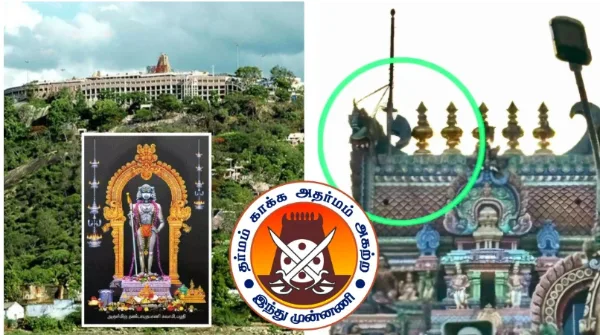CHENNAI: Devotees of the renowned Palani Dandayuthapani Swami Hill Temple, one of the six sacred abodes (Arupadai Veedu) of Bhagwan Murugan, were left shocked after part of the Rajagopuram (main temple tower) was found damaged. Palani Temple, a major pilgrimage site in Tamil Nadu, attracts thousands of visitors daily from across the state and beyond. During significant festivals like Thaipusam and Panguni Uthiram, the temple witnesses crowds of devotees in the lakhs, making it one of the most visited temples in India.
The temple recently underwent its Kumbabhishekam (consecration) ceremony on January 27, 2023, following a 16-year gap. However, just over a year later, parts of the Rajagopuram, particularly the horn-like structures on both sides, have broken off, leaving devotees deeply concerned about the temple’s structural integrity. A temple official confirmed the incident, stating, “It is true that a part of the Rajagopuram has been damaged. We are in the process of rehabilitating the area, and a small-scale Kumbabhishekam and reparation puja will be performed after the repairs. Devotees should not be alarmed.”
The unexpected damage has raised several questions, and experts are currently investigating the cause of the structural failure. Restoration efforts are being closely monitored to ensure the temple’s safety and to preserve its sanctity.
History of Renovation and Kumbabhishekam
It is important to note that the Palani Temple had undergone major renovations in 2019. However, due to the COVID-19 pandemic, the temple’s palaalayam ceremony (interim ritual before the Kumbabhishekam) was delayed by three years before finally taking place in January 2023. The Kumbabhishekam was a significant event for the temple and its devotees, as it marked the rejuvenation of the holy site. Yet, the damage to the Rajagopuram so soon after the ceremony has sparked outrage among devotees and religious organizations alike.
Hindu Munnani’s Strong Condemnation
Hindu Munnani, a prominent Hindu nationalist organization, has expressed strong condemnation regarding the damage to the Rajagopuram. In a statement, the organization described the Palani Sri Dandayuthapani Swami Temple as one of Tamil Nadu’s most iconic and revenue-generating temples. They criticized the temple administration and the Tamil Nadu government for what they called the “hasty and poorly planned” Kumbabhishekam, conducted without proper preparation or due diligence.
Hindu Munnani had previously warned against rushing the Kumbabhishekam, emphasizing that the ritual, according to Agama traditions, should only be performed once every 12 years following a thorough assessment of the temple’s condition. The organization claimed that the structural integrity of the temple had been compromised because of the hurried nature of the ceremony.
Furthermore, Hindu Munnani criticized the explanation provided by the temple administration that monkeys were responsible for the damage to the Rajagopuram. The group called this justification “absurd and lame,” asserting that a sacred structure should not be so fragile as to be damaged by monkeys. They also raised concerns about the safety of the temple’s visitors and urged for a comprehensive reassessment of the temple’s stability before any further rituals or poojas are carried out.
Concerns Over Broader Temple Management
In addition to the Palani Temple incident, Hindu Munnani also questioned the overall management of Hindu temples under the state’s Hindu Religious and Charitable Endowments (HR&CE) department. They highlighted several recent incidents, such as the overturning of temple chariots, the untimely death of temple elephants, and other structural damages at various temples, as indicative of broader administrative failures.
The group specifically called out Tamil Nadu’s Charities Minister, P.K. Sekar Babu, for claiming that over 2,000 Kumbabhishekam ceremonies had been conducted at temples across the state under the Dravida Model. Hindu Munnani questioned whether these ceremonies were similarly rushed and substandard, urging the HR&CE department to provide transparency and accountability for the Palani Temple incident.
They demanded an immediate inquiry into the damage and called for a thorough reassessment of the temple’s safety to prevent further risks to devotees. The organization also warned that incidents like this could be interpreted as “bad omens” for the state’s rulers and urged the government to prioritize the preservation and protection of Hindu religious institutions.
Criticism of Government Control Over Hindu Temples
Critics of the state’s handling of temple affairs have also pointed to broader issues under the HR&CE department. They argue that the department, as highlighted by the High Court, appears more focused on revenue generation than on the upkeep and preservation of temples. This sentiment has been fueled by incidents where devotees were allegedly denied permission to follow traditional customs, as well as by erratic increases in darshan and service charges, which have disproportionately affected poorer devotees.
Many argue that temples, historically built as community centers where all could visit and pray, have become increasingly inaccessible under government control. They question why similar financial burdens are not imposed on mosques, churches, or other places of worship, while the government provides subsidies for pilgrimages to Mecca, Medina, and Jerusalem using taxpayer money.
Calls for a Sanatana Board
Given the perceived failures of the HR&CE department, many within the Hindu community are calling for the establishment of a Sanatana Board, akin to the Waqf Board, to protect Hindu temples and their vast properties. Proponents argue that such a board would ensure that temples are managed by individuals who are deeply invested in preserving the cultural and religious significance of these sacred spaces, free from political or financial motivations.



















Comments